Do-it-yourself pyrolysis boiler: device, circuits, principle of operation
The term "pyrolysis" refers to a process where there is a delayed burning of solid fuel to produce a gaseous medium. Despite the “professorial” name of the structure, making a pyrolysis boiler with your own hands is relatively simple, and homemade products are quite common in practice.
The explanation is simple - a wood-burning gas boiler is easier to maintain, often more efficient and more economical than other similar equipment. Let's look at how such equipment works and what is needed for its manufacture.
The content of the article:
The principle of operation of pyrolysis boilers
Boilers of heating systems, where solid combustible materials are used as fuel, in addition to the classics, also belong to pyrolysis structures. Usually they are called gas-generating boilers.
In order to better understand the principle of operation of a home pyrolysis boiler, it is logical to carefully consider the device of such a technique. Let's start with the features of the furnace as the main part of the heating structure. In fact, the working area of the fuel chamber of the pyrolysis boilers is divided into two separated chambers.
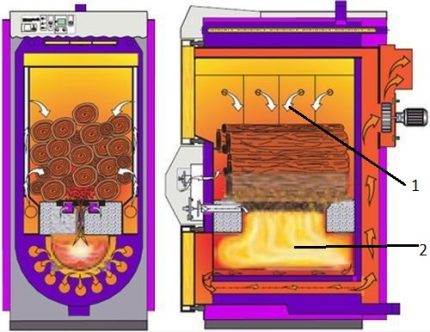
One of these chambers is loaded with solid fuel - firewood, pellets, briquettes, etc. There begins the primary process of burning solid fuel with limited air supply. In this state, the fuel does not burn, but smolders. Gases emitted during slow combustion enter another area of the chamber - the active one, where they burn out intensively even with increased air supply.
Technically, a similar combustion process is implemented in a simple manner. The subregions of the common chamber are simply separated by the grate and nozzle. The upper part of the chamber is a passive furnace, the lower part of the chamber is an active furnace. In this case, a design feature should be taken into account - the upper air supply to the fuel chamber (upper blast).
Actually, this distinguishes the design of the gas boiler from the classic single-chamber design, where the lower flow is used.
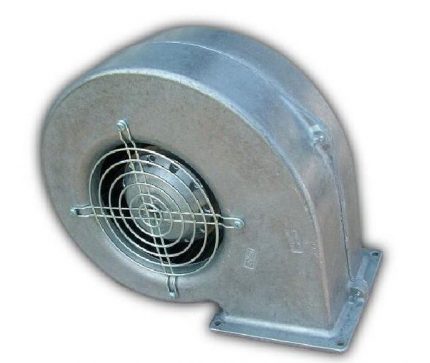
Technologically, for the arrangement of pyrolysis boilers, a characteristic moment is also the organization of forced draft. The design of the two-stage firebox has high aerodynamic drag. Therefore, there is no way to do without installing an air pump.
How does the boiler function in practice?
It is convenient to consider the practical use of equipment in a step-by-step process:
- Loading firewood - laying on the grate of the upper area of the camera.
- Ignition of fuel and start-up of the smoke pump.
- The formation of wood gas at a temperature of 250-850 ° C.
- The transition of wood gas to the lower region of the furnace.
- Combustion of wood gas with additional air supply.
Further, the heat obtained in the lower region of the fuel chamber is used to heat the coolant. The coolant can be both aqueous medium and air.
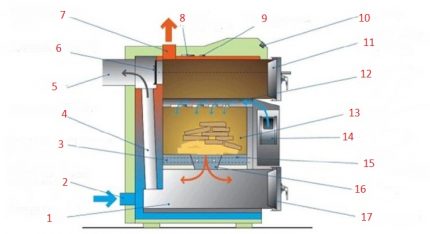
If you pay attention to all existing designs of home boilers operating on solid fuel, the traditional alternative is the main alternative to the pyrolysis boiler.
This is a similar version of a wood-fired boiler, where there is one undivided firebox and the principle of lower air supply to the combustion chamber works. But such a system is considered less efficient and uneconomical due to the rapid combustion of fuel.
The pyrolysis boiler is capable of producing a coefficient of performance at the level of 85-95% under the condition of 100% load. However, the efficiency drops sharply if the load is less than 50%. That is why manufacturers of pyrolysis equipment recommend users to operate equipment with maximum load.
A similar approach is true for home-made structures, provided that they fully comply with the classical pyrolysis scheme and operating requirements.
For the “pyrolysis" operation requirements, it should be noted, rather stringent:
- mandatory equipment with an air pump;
- permissible fuel moisture not higher than 25-35%;
- equipment load not less than 50%;
- return temperature not lower than 60 ° С;
- loading only with a large fuel mass.
It should also be noted the high cost pyrolysis systems industrial manufacturing. This is probably why the do-it-yourself option is very popular.
Homemade pyrolysis boiler
As a rule, in the manufacture of such heating equipment with their own hands, the popular Belyaev scheme is taken as the basis. This is not to say that this is a simple solution that allows you to make a heater without problems. But, perhaps, one of those solutions that can really be implemented.
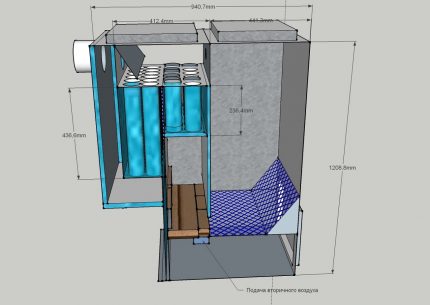
For the production of equipment according to this scheme, the master will need:
- metal pipe (d = 32; 57; 159 mm);
- profile pipe (s = 60x30; 80x40; 20x20 mm);
- steel strip (20x4; 30x4; 80x4 mm);
- fireclay brick;
- a metal sheet;
- air pump;
- temperature sensor.
It is also necessary to have a complete set of bench tools, plus a welding machine (and welder skills, respectively).The work on the manufacture of a pyrolysis boiler with your own hands is clearly not overpowering alone. At least one assistant is needed.
First of all, in accordance with the selected scheme, it is necessary to prepare sheet details of the structure. It is recommended to prepare sheet panels, cutting them to size with professional precision equipment.
Application for cutting a hand tool such as "grinder" also requires some skills and safety precautions during operation, but does not ensure cutting accuracy, which subsequently affects the quality of welding performance. This point should be taken into account. A reasonable solution for cutting metal sheets is an order in a mechanical workshop.
Assembly of internal parts of equipment
From one part of the metal sheets it is necessary to make a fuel chamber. For this, a material commensurate with the circuit parameters is connected and welded. A two-chamber design should be obtained, which should be supplemented with air ducts.
These elements of the fuel chamber are made of a metal channel or a profile pipe is used for manufacturing. Holes are drilled over the entire area of the front side of the duct.
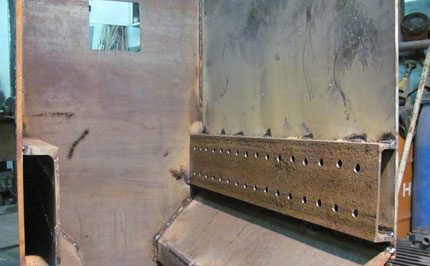
Lower in level, in the region of the active combustion chamber, a metal pipe (secondary air supply) crashes on a wall located across the air ducts. Next, work begins with pipes, since the turn of assembling a tubular heat exchanger has come.
This part of the pyrolysis system is made of metal pipes d = 57 mm:
- Two metal sheets are taken to the size of the drawing and marking is done.
- Based on the marking for the location of the pipes, holes d = 60 mm are cut out on the sheet.
- Pipes d = 57 mm in length are cut.
- The ends of the pipes are inserted into the holes of one sheet and scalded.
- Repeat the operation with another sheet.
The output should be a finished heat exchanger, which is fastened to the boiler body where the circuit indicates.
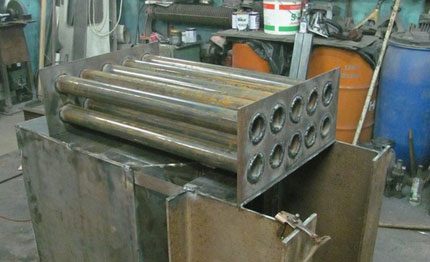
A throttle valve is installed next to the heat exchanger (at the upper level). This part is equipped with a handle and is also welded to the structure. The end part of the throttle body is closed with a piece of sheet with a pipe under the chimney.
Then it remains only to weld the front panel of the fuel chamber with windows for doors under each of the two sections and a module for the air pump.
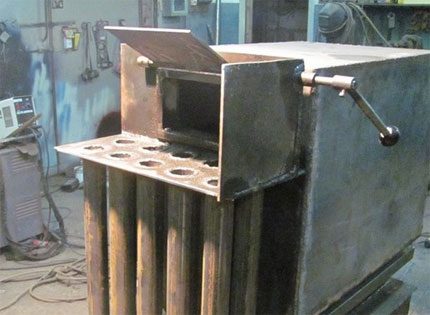
Before installing the front panel, the inside of the combustion chambers must be reinforced with fireclay bricks. This material is cut to size, some at an angle. The brick is grinded and adjusted at the place of laying.
Both fire sections of the boiler fuel chamber are exposed to fireclay bricks. At the same time, the area of the flaps of the air exhaust (supply) pipes is neatly laid around. After laying out the brick, the front panel is installed.
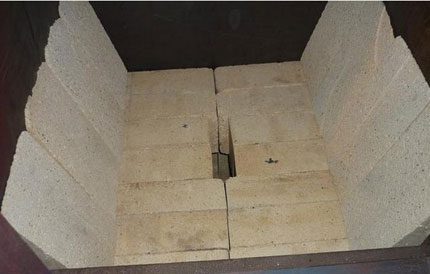
In fact, the main assembly of the pyrolysis boiler at this stage can be considered completed. The assembled structure must be processed - remove scale from welding, clean welds, trim if there are slight irregularities somewhere.
The next step is the conclusion of the assembled structure in a sealed enclosure.This part of the structure is also made of metal sheets. However, pressure testing is needed first.
Testing and final assembly of the structure
The assembled structure must be tested. Mandatory actions - check for tightness of the boiler area where the coolant should circulate. To conduct pressure testing of the heat exchanger, plugs are temporarily installed on the supply and return pipes of the coolant.
Then the heat exchanger is charged with water. It is advisable to use hot water from the heating network or hot water supply in order to be able to check welds in the conditions of thermal expansion of the metal.
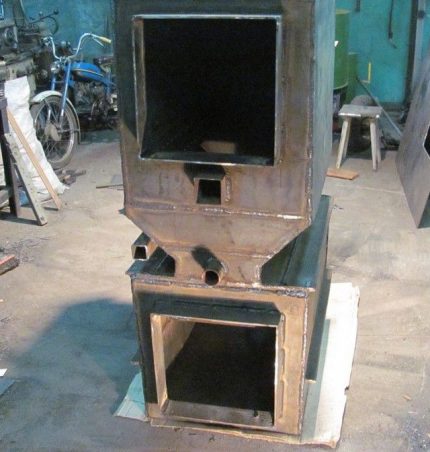
If there are no leaks at the seams of the heat exchanger, the water is drained and the metal structures of the pyrolysis boiler are framed by external metal panels. Also at this stage the doors of the windows of the sections of the combustion chamber are manufactured and hung.
The doors of the pyrolysis installation require execution taking into account high-temperature operating conditions. Therefore, these structural elements are usually made (or used already made) of cast iron with additional thermal reinforcement by chamotte brick.
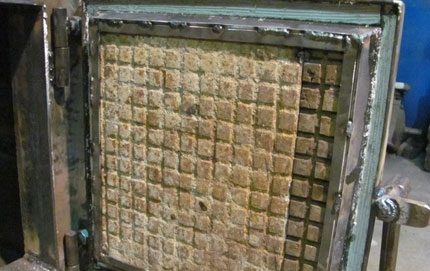
The final stage is the installation of a pyrolysis boiler in the place of its future operation. Installation of the structure is carried out on the foundation or on a concrete slab. The height of the foundation (slab) relative to the ground level is recommended to maintain a size of not less than 100 mm.
After installation and balance by levels, the lower part of the boiler is fixed to the foundation. It remains to connect the chimney, install an air pump and connect the coolant supply / exit lines.
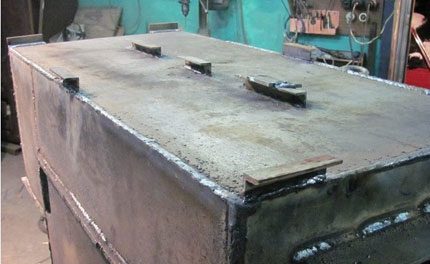
Making a pyrolysis boiler design on your own is a job that requires a significant investment of effort. Of course, you can not do without overhead in terms of financial resources.
Perhaps, the purchase of material and the use of third-party services will cost less than the cost of industrial equipment. However, the difference is likely to be not so significant. But the main question is not about money.
Conclusions and useful video on the topic
On the independent manufacture of a pyrolysis boiler:
Technically independent production of pyrolysis boilers without the availability of an appropriate base is an extremely complex process. Also required are professional skills in working with metal, a clear understanding of engineering schemes and technological subtleties of manufacturing boiler equipment. Without all this, you should not even take up work.
If you possess the necessary knowledge and skills, and can give valuable advice on assembling the pyrolysis boiler to other visitors to the site - please leave your comments, share the secrets of skill, ask questions in the block under the article.

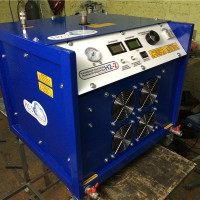 Hydrogen heating boiler: device + principle of operation + selection criteria
Hydrogen heating boiler: device + principle of operation + selection criteria 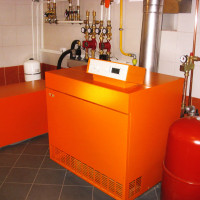 Gas boiler with an electric generator: device, principle of operation, an overview of the best brands
Gas boiler with an electric generator: device, principle of operation, an overview of the best brands 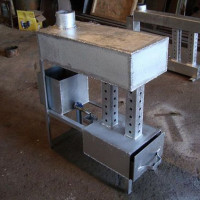 Do-it-yourself oil boiler: making a homemade waste boiler
Do-it-yourself oil boiler: making a homemade waste boiler  Do-it-yourself heating boiler piping: schemes for floor and wall boilers
Do-it-yourself heating boiler piping: schemes for floor and wall boilers 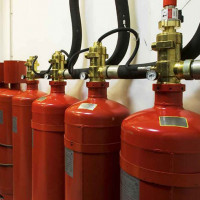 Gas boiler for liquefied gas: operating principle, types, how to choose the right + manufacturers rating
Gas boiler for liquefied gas: operating principle, types, how to choose the right + manufacturers rating 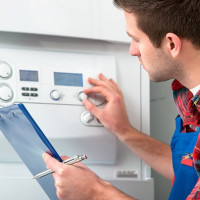 Adjustment of gas boiler automation: device, principle of operation, tuning tips
Adjustment of gas boiler automation: device, principle of operation, tuning tips  How much does it cost to connect gas to a private house: the price of organizing gas supply
How much does it cost to connect gas to a private house: the price of organizing gas supply  The best washing machines with dryer: model rating and customer tips
The best washing machines with dryer: model rating and customer tips  What is the color temperature of light and the nuances of choosing the temperature of the lamps to suit your needs
What is the color temperature of light and the nuances of choosing the temperature of the lamps to suit your needs  Replacement of a geyser in an apartment: replacement paperwork + basic norms and requirements
Replacement of a geyser in an apartment: replacement paperwork + basic norms and requirements
At the stage of building a house, I fired up to buy a pyrolysis boiler, such as it can process any type of fuel and its efficiency is high. But he went shopping, looked at prices and changed his mind. The boilers, which are cheaper, are thin-walled, but I didn’t pull the expensive import one.
I definitely won’t do it myself, I have to be a professional welder, and I cook at the household level. Well, investments in metal, pipe, and additional tools are also considerable. Although, when you do it for yourself, you’re sure of the quality, that's for sure.